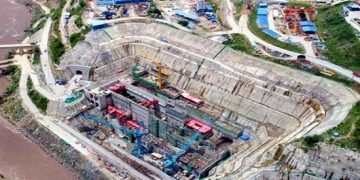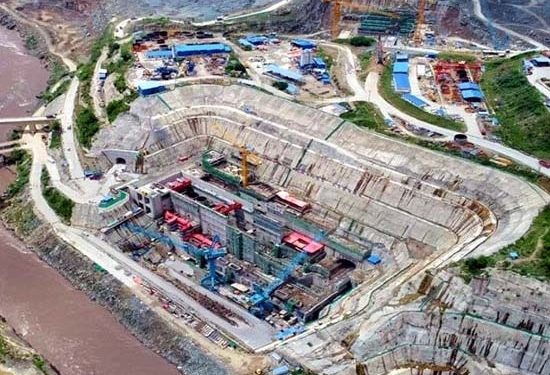China Pakistan Eco nomic Corridor (CPEC) has succeeded to reduce energy deficits of Pakistan through the completion of numerous energy projects in the country.
According to official statistics (2021-2022) Pakistan is blessed with enormous hydropower potential up to some 40,000MW that has not yet been harnessed effectively and optimally. In this regard, various hydropower project sites have been identified across the country and their technical and economic feasibility determined. In this context the energy policy commonly known as Indicative Generation Capacity Expansion Plan (IGCEP) 2021-2030, has focused on utilising indigenous resources for power generation, and thus developing hydropower on a large scale during the decade, aiming at providing affordable, clean, and renewable energy. However, under the flagship projects of CPEC many beneficial projects of hydropower must be included in the CPEC Phase-II.
In this connection, sincere efforts have been initiated to finalize the development of hydro projects along the north Indus River including the Bhasha Hydropower project as agreed in the 4th JEWG meeting of 3rd Aug, 2016 in Lahore.
Most recently, Karot Hydropower Plant, the first hydropower investment project under the CPEC has now been put into full commercial operations.
During the launching ceremony Wu Shengliang, chairman of the China Three Gorges International Corporation, said the project serves as a bridge of friendship between China and Pakistan.
The start of commercial operations was the latest outcome of the construction of energy projects under CPEC, he said, adding the project provided quality and affordable green energy to support economic growth in Pakistan.
It is located 55km away from Islamabad the project is constructed by the China Three Gorges Corporation, with an installed capacity of 720,000 kilowatts.
According to a handout by the project, the plant will reduce 3.5 million tonnes of carbon emissions per year and meet the power demand of about 5 million people.
Earlier, Chinese Foreign Ministry spokesperson Zhao Lijian had remarked that the project would not only meet the electricity needs of around 5 million local residents, it will also improve Pakistan’s energy structure and fill the widening gap.
It will boost the country’s sustainable development,” he added. Answering a question about Prime Minister Shehbaz Sharif’s visit to the project site last week during a regular briefing, Zhao said. “The Karot hydropower plant is a major energy cooperation project between China and Pakistan.”
PM Shehbaz spoke to the engineers and workers at the project site during the visit. “Once all units are installed and put into operation, the project will help meet the electricity needs of approximately 5 million local residents,” he added.
The Karot hydropower project being completed under the CPEC would not only meet the electricity needs of around five million local residents, further improve Pakistan’s energy structure but also boost the country’s sustainable development, Chinese Foreign Ministry spokesperson Zhao Lijian.
“The Karot hydropower plant is a major energy cooperation project between China and Pakistan,” he said during his regular briefing in response to a question about Prime Minister Shahbaz Sharif’s visit to the project last week.
PM Shehbaz Sharif also spoke to the engineers and workers of the project during the visit.
“Once all units are installed and put into operation, the project will not only generate steady and affordable energy supply, meet the electricity needs of approximately 5 million local residents and further improve Pakistan’s energy structure but also boost the country’s sustainable development,” he added.
Zhao Lijian said that the hydropower plant was expected to reduce carbon dioxide emissions by around 3.5 million tons per year which would make new contribution to the global response to climate change.
Invested by China Three Gorges Corporation, the Karot hydropower project in Punjab province is the fourth level of the five cascade hydropower stations planned for the Jhelum River. It will be operation soon and produce 720-megawatt off clean energy.
“We wish the project a speedy completion and construction so that it can be put into operation at an early date,” he added.
The spokesperson said that CPEC was a key pilot project under the Belt and Road Initiative (BRI) and an important platform for all round practical cooperation between the two countries.
The CPEC was guided by the concept of green open and clean development and committed to realizing sustainable, livelihood oriented and high standard growth.
Since its launch, the CPEC has delivered fruitful outcomes in energy cooperation, which helped Pakistan to effectively tackle energy shortage and provides reliable and ample energy supply for its economic and industrial development, he added.
The national plan envisages an addition of 13,148MW hydropower capacity at national level by 2030; more than hydropower installed capacity available currently. Existing hydropower generation capacity is cumulative 9,873MW, which has about 29 percent share in overall energy mix of total 34,501MW (National Transmission and Despatch Company-NTDC system), as on May 30, 2021.
According to projections given in the IGCEP, installed hydropower capacity will rise to cumulative 14,353MW by the year 2025 resulting in 31 percent share, and to 23,036MW by 2030 resulting in 43 percent share, in total power generation capacity by then from all resources. An appraisal of the plan however reveals that these projections are far from being realistic, and it would not be practically possible to achieve set targets. Various hydropower projects, particularly medium and mega projects, are already behind the schedule.
Currently, 18 small, large, and medium hydropower stations are in operation, besides many mini and other small hydropower stations, with Pakistan Water and Power Development Authority (WAPDA), provincial governments, and Independent Power Producers (IPPs), which are connected to national grid. These are Tarbela including 2nd and 3rd extensions (3,478MW), Tarbela 4th extension (1,410MW), Ghazi Barotha (1,450MW), Mangla (1,000MW), Neelum Jhelum (969MW), Warsak (243MW), Chashma (184MW), Patrind (150MW), Dubair Khwar (130MW), Allai Khwar (121MW), Golen Gol (108MW), Gulpur (102MW), Jinnah (96MW), New Bong (84MW), Malakand-III (81MW), Khan Khwar (72MW), Daral Khwar (37MW), Jagran-I (31MW), and Jhing (14MW).
It is high time that the incumbent government, policy makers and all main stakeholders should chalk out a comprehensive road map for further enhancing of hydropower projects in the country under the flagship CPEC. It would be a balancing act which would also reduce energy cost and doing of business in the country.
- Latest
- Trending






